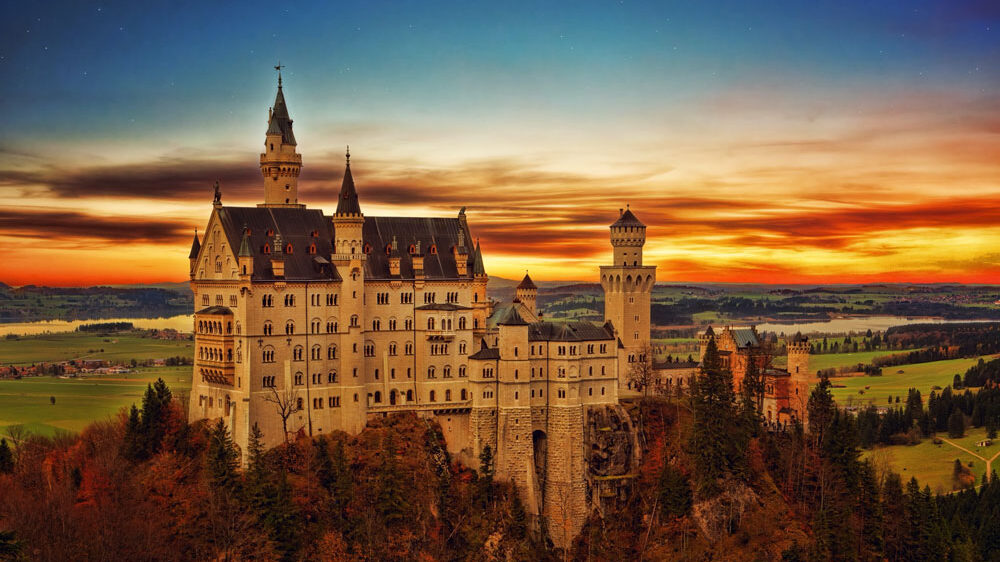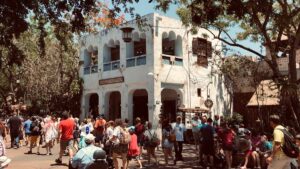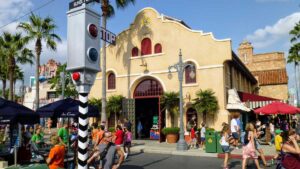We’ll do a slightly different kind of post this time. We have already done one on the architecture of Cinderella Castle at Magic Kingdom. This time we’ll focus on the inspiration for Cinderella Castle – the historical precedents that influenced the design of one of the most recognizable structures in the world.
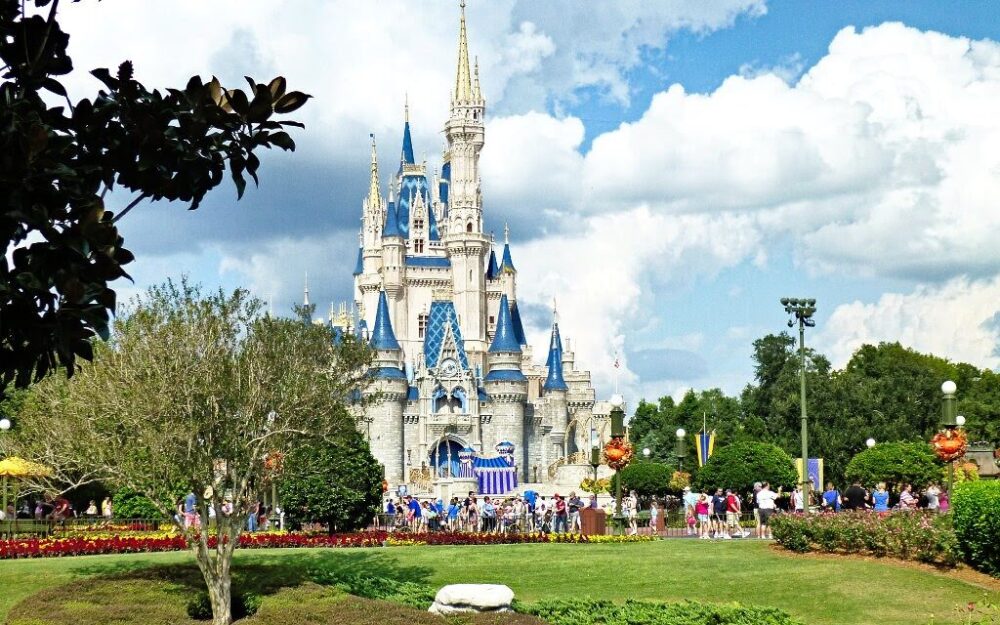
To be clear, Cinderella Castle is not a direct facsimile of any one historical example. Instead, it’s an amalgamation of many castles and chateaus across Europe. In fact, much of it is not directly influenced by any specific castle. But as we’ll see below, there are echoes of several historical castles in elements on Cinderella Castle.
Herbert Dickens Ryman, the chief designer of the Castle at the Magic Kingdom, didn’t limit himself to architectural examples in France (the setting of Cinderella). Instead, he used Gothic Revival buildings throughout Europe as inspiration. We’ll keep this simple and just visit (virtually… I make no money on this blog) some of these historical examples, and look for their influences on Cinderella Castle. OK? Good.
Since we’re going to visit 10 castles, we’ll have to attack this in two parts. So… Part One… here we go
Château de Fontainebleau, France
The Precedent
Sitting adjacent to an ancient forest, Château de Fontainebleau, was used for 8 centuries as a hunting lodge for the kings of France (including Louis XIV and Henri IV) and Napoleon Bonaparte. The Château is an enormous complex – a long and irregular mass of buildings consisting of 1,500 rooms. It’s roof alone covers 5 acres – a huge area until compared with the overall property itself, which clocks in at 230 acres!
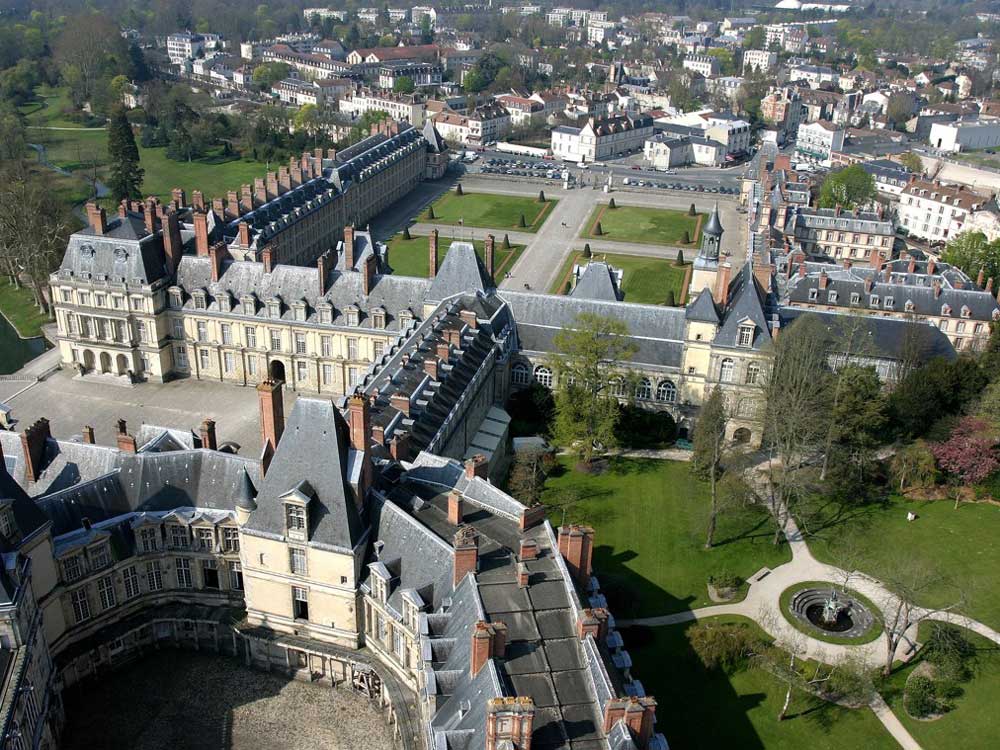
The first building on the site dates from 1137 A.D., although most of the meandering complex was built in the early 1500s and later. Francois I, in fact, transformed the hunting lodge into a full-fledged palace in 1528 A.D. Today, Château de Fontainebleau comprises five courtyards placed in an irregular manner framed by an astonishing number of buildings and gardens.
Some have said that the Italian Renaissance arrived in France with the expansion of the palace in the early 1500s. The New York Times says, “”The result is a unique amalgam of Italian exuberance and artistic genius joined to French subtlety and classical restraint.”
The Inspiration for Cinderella Castle
The inspiration for Cinderella Castle at Magic Kingdom is apparent in the tall, hipped mansard roofs that top several of the entrances and towers of Château de Fontainebleau. The source material’s signature roofs are slate and have dormers and central parapet-like ornaments sitting in front of them. The one shown below, at the main entrance, has two brick chimneys flanking it, and a ridge crest and elaborate finials crowning it. Both the ridge crest and the finials are purely decorative caps to roofs that draw the eye skyward.
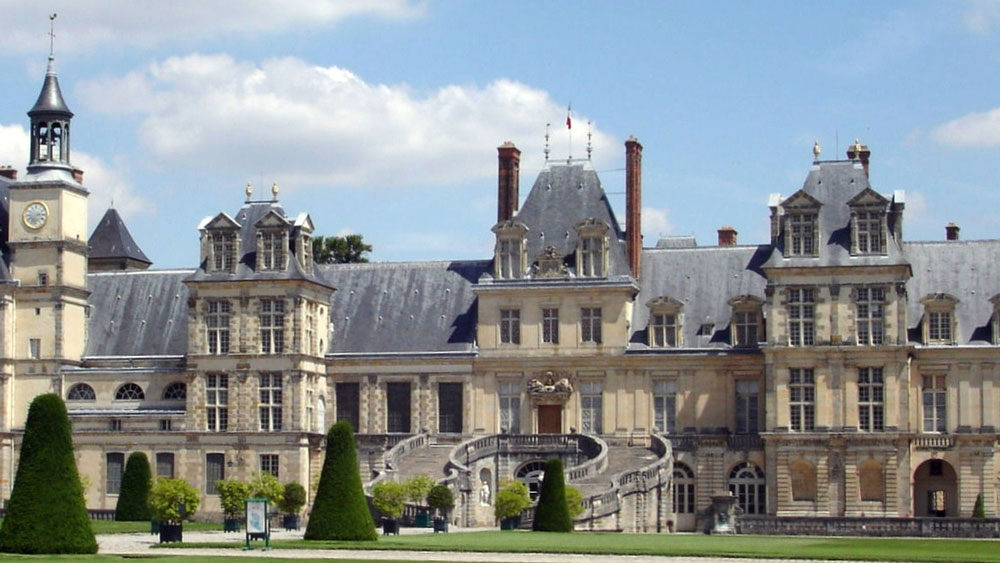
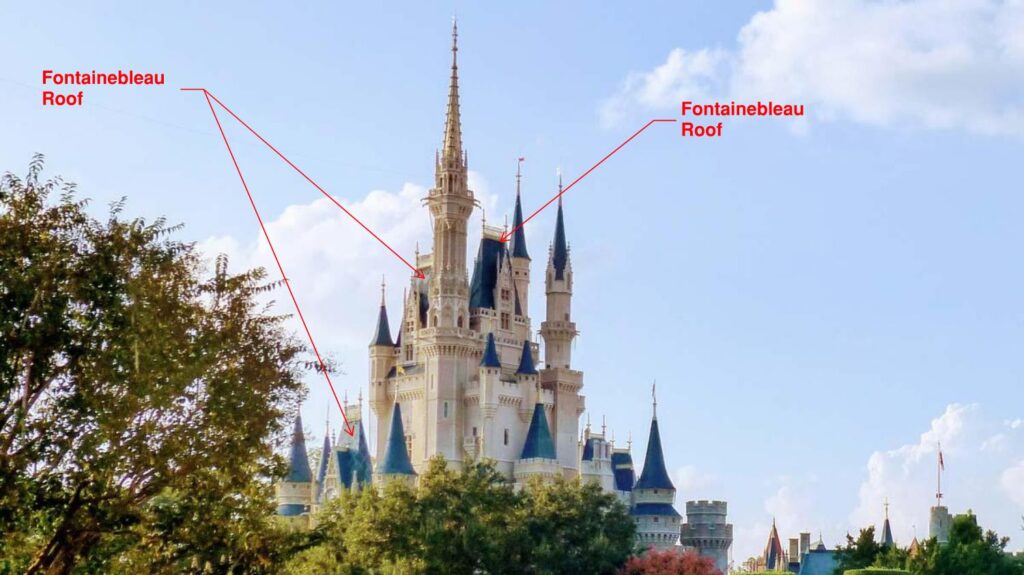
Cinderella Castle has three of these Château-de-Fontainebleau-inspired roofs, including the entrance tower. All three of the examples have elaborately detailed stone dormers – almost Gothic in nature. And they each host very exaggerated gold ridge crests and finials.
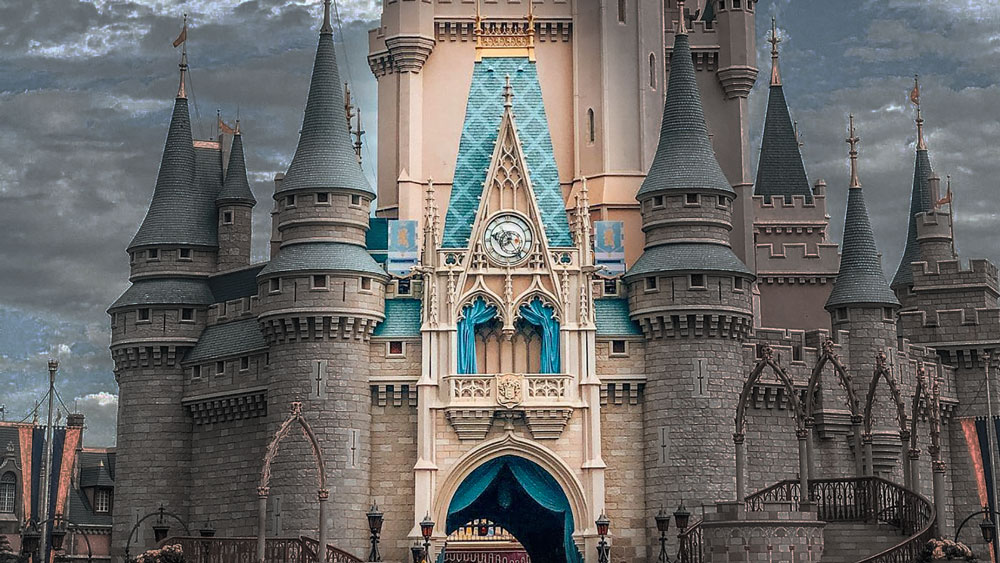
Unlike a true “dormer”, the one at the entrance tower doesn’t have a window into an attic room, but instead serves as a canvas for the extravagant clock face. You can also see the exaggerated height of the roofs on the Castle – much steeper than the ones at Château de Fontainebleau. This helps add a bit of the fantastical to the design.
Neuschwanstein Castle, Germany
The Precedent
Located in Southwest Bavaria, Neuschwanstein Castle was built by “Mad King” Ludwig II. Construction on the private retreat started in 1868 but was never completed. It’s quite the paradox – the romantic design emulates castles from medieval times. However, the palace dates from when strongholds were no longer necessary, and the castle contains running water and a central heating system.
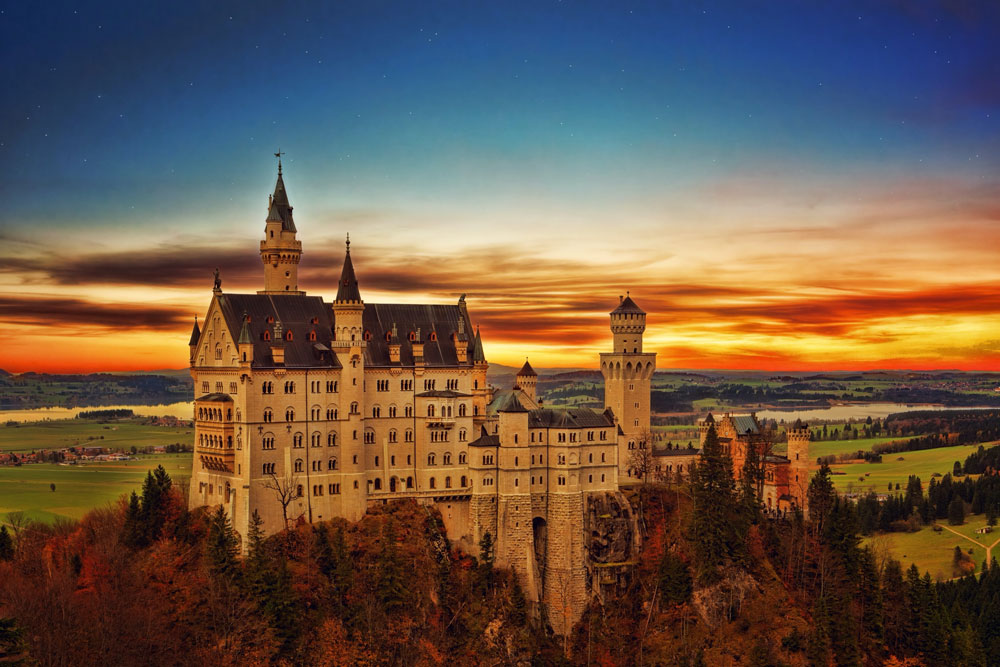
It’s a blending of a few different architectural style – Gothic and Byzantine among them. But, Neuschwanstein Castle is largely Romanesque in its architecture – with its massive and heavy aesthetic and rounded arches.
The Inspiration for Cinderella Castle
Neuschwanstein Castle is certainly an influence of Cinderella Castle. But, it’s not quite as strong as is commonly said. The Bavarian castle actually serves as the primary inspiration for Sleeping Beauty Castle at Disneyland in California. You can see the similarities very clearly in the images below:
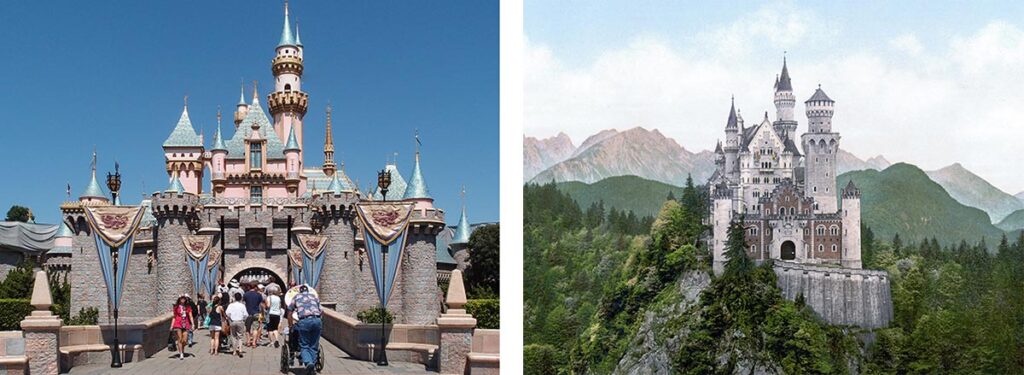
But, its connection to the Castle at Magic Kingdom is a bit more subtle. Cinderella Castle is heavily Gothic-inspired, as you can read in this post. So, the visually heavy, rounded-arched Romanesque style found at Neuschwanstein is much less apparent there. That’s not to say there aren’t echoes of the Mad King’s castle in Florida’s version, starting with the asymmetrical massing so evident in the picture above.
Turrets and Battered Walls
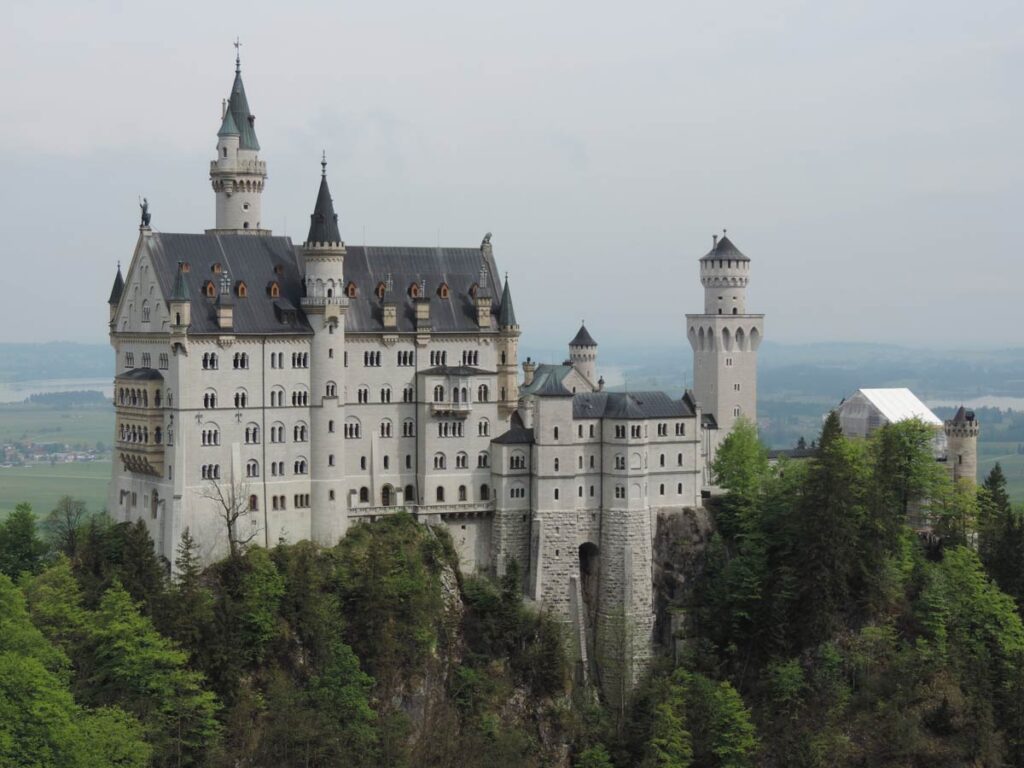
At Neuschwanstein, the lowest portions of the exterior walls, as seen above, are battered (the walls flare out and thicken as they meet the ground). They also have a rough stone texture, as opposed to the rest of the castle, which has a smooth limestone finish. Also visible at the four corners of the tallest portion of the complex – the keep – are small projecting turrets (towers that protrude from the wall and don’t reach the ground).

And in Cinderella Castle, we see that the outer fortified wall appears made of large stones and does also flare out as it extends down to the surrounding moat. The Upper Keep of the Castle also hosts projecting turrets, just like the Mad King’s Palace.
Tower #20
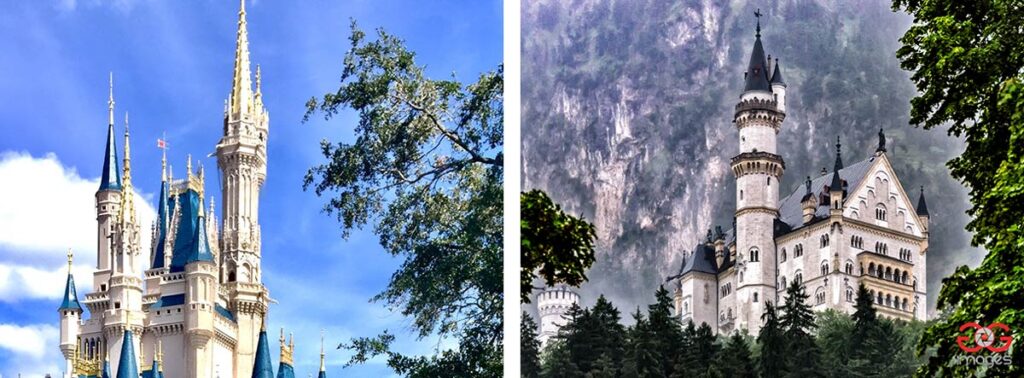
The tallest spire of Cinderella Castle (Tower #20), although stylistically more Gothic and opulent, is heavily influenced by the tallest tower at Neuschwanstein Castle. The lower portion of the tower is octagonal, at which point a projecting band delineates a change in the tower. In the precedent, the tower switches to a cylindrical tower, while at Cinderella Castle, the tower begins its ornate decadence. Both versions have a small turret that projects from the main tower up near its spire. The tower at Neuschwanstein is clearly an inspiration, even if not it’s not a direct facsimile.
Alcázar of Segovia, Spain
The Precedent
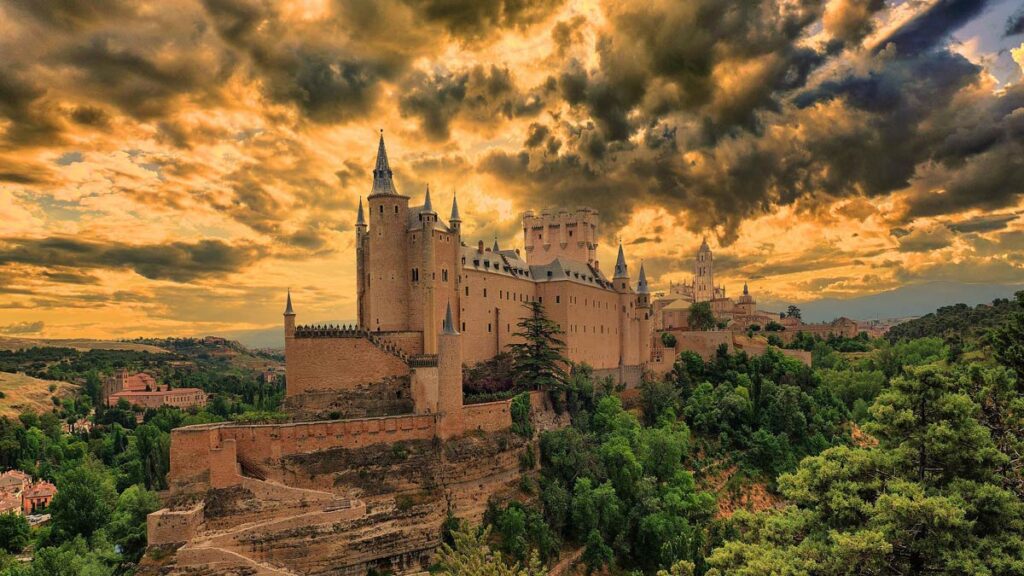
We’ve been to France and Germany, and now we travel to Spain for our next inspiration for Cinderella Castle. Alcázar de Segovia is a medieval castle built in the 11th-12th centuries on a rocky crag in the community of Castile and León. Its shape, sitting atop the promontory, resembles the bow of a ship.
Added to over several centuries, the castle is quite an eclectic mix of architectural styles. The Tower of John II near the entrance, has a Moorish influence. The overall layout, and the flat, unadorned exterior walls are Herrerian – a Spanish Renaissance style. And the spires of the many towers – the most “Disney” of the elements – are a Romantic Gothic style.
The Inspiration for Cinderella Castle
It is rumored – though not officially confirmed – that this castle is the primary inspiration for the Cinderella Castle at Magic Kingdom. There are several places in the Magic Kingdom’s castle where you can see elements from Alcázar de Segovia.
The Approach to the Castles
Right off the bat, when approaching the entrance to the castle, it is apparent that the main façade compositions of the two castles are similar.
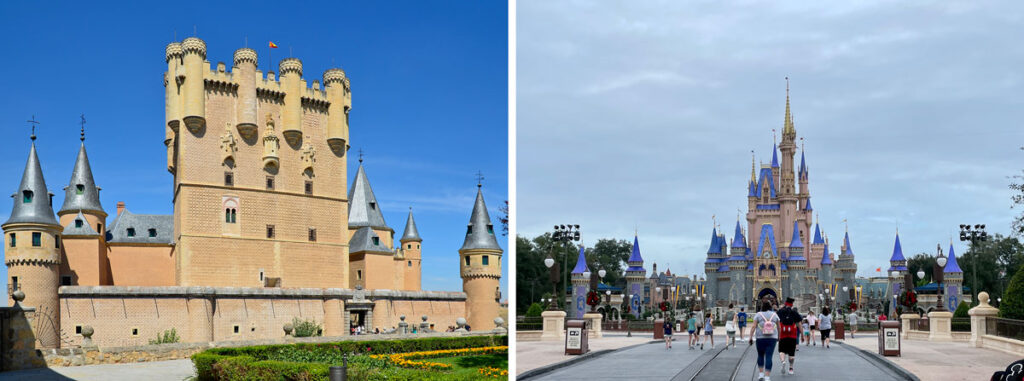
The massive entrance tower in the Spanish version doesn’t necessarily translate. But, notice how the relatively squat spired towers, engaged in the lower wall, are spread way out to the edges of both castles. In this way, they mark the boundaries of the property while allowing the taller mass of the castle to dominate at center.
The Spires
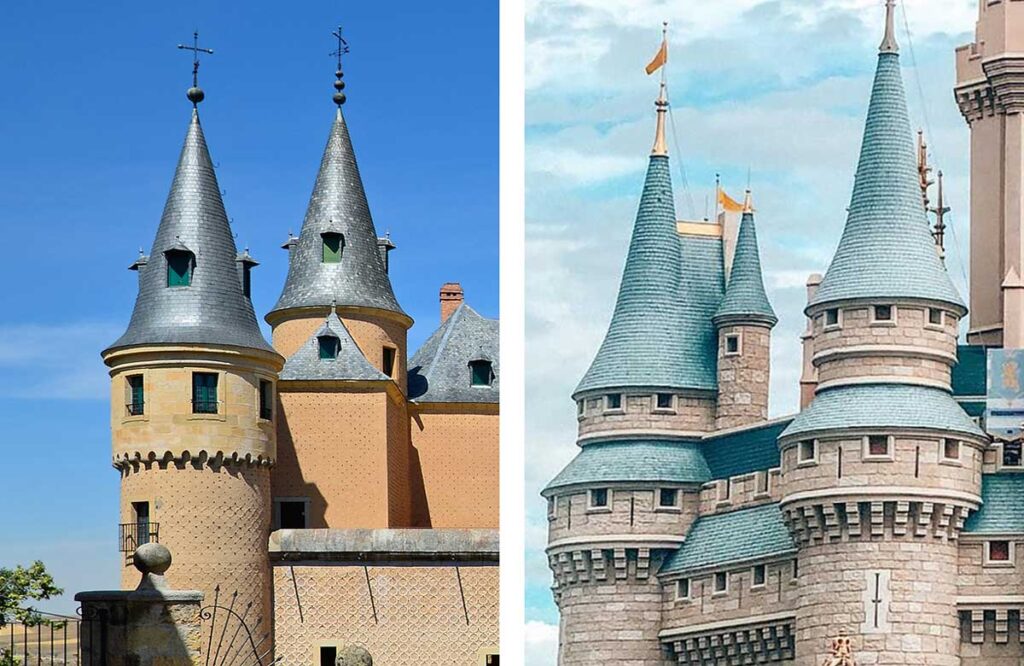
The spires themselves are also extremely similar. Yes, Cinderella Castle’s roofs have a fantastical bright blue hue, quite different from the charcoal-colored slate roofs at Segovia. And at Magic Kingdom, many of the towers have a unique double-roofed motif, which we’ll discuss in later castle precedents. But, the proportion and shape of the spires are almost identical. The spire roofs of both buildings begin from the top with a very steep conical shape that flares out at the bottom (a splay-foot spire). Pinnacles sit atop both castles as well. The dormers interrupting the tower roofs at Alcázar de Segovia aren’t found in Florida’s version.
The Keeps of the Castle
The entire castle complex at Segovia is far more spread out than Cinderella Castle. But, the keep at the far end of the Castle, at the edge of the promontory, bears a strong resemblance to the keep of the Castle at Magic Kingdom. A keep is the portion of the castle where, historically, the royal family dwelled. It was also usually the tallest, safest place within a Castle.
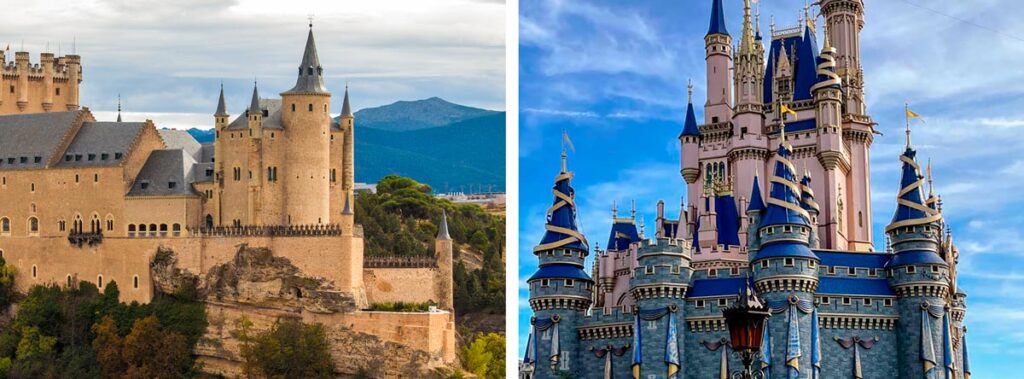
Far less ornate than the one in Florida, the mass and proportions of the royal stronghold in Spain, nonetheless, looks very similar. Both versions have box-like masses, although Cinderella Castle’s has many more towers protruding from, and glommed on to its box. Alcázar de Segovia has a large tower sitting in the center of the façade with a funky off-centered tower, along with thin, diminutive towers on each of the four corners of the keep. At Cinderella’s Castle, there isn’t such a hierarchical central tower, but the small corner towers are there – except they are projecting turrets instead. All in all, it’s pretty obvious that Alcázar de Segovia was a big inspiration for Cinderella Castle.
Moszna Castle, Poland
OK – on to Poland…
Speaking of… man, these Imagineers searched far and wide didn’t they? I would have loved to have been in the room when they pitched Roy E. Disney on the European Vacation Research Trip they just NEEDED to take to get the Castle right…
The Precedent
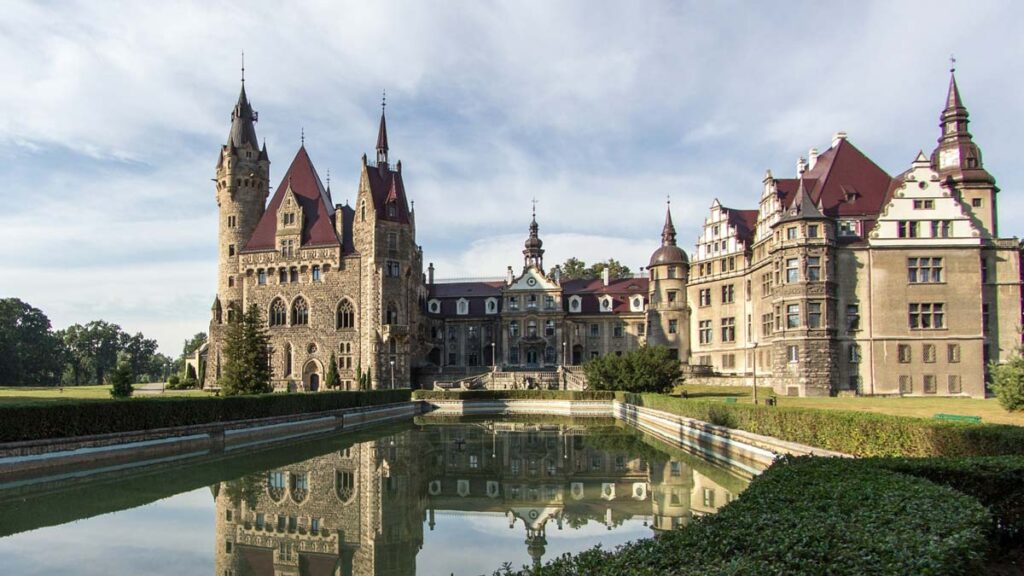
Moszna Castle – at least one portion of it – is another European castle that influenced the design of Cinderella Castle. I say “one portion” because the Polish castle is an eclectic mix of architectural styles. This is due to its various wings being built over a long period of time. The original central portion of the castle is a reconstruction of an 18th century baroque palace, which had been destroyed by fire. The western wing, built in the Neo-Renaissance style (on the right-hand side of the image above), was finished in 1914.
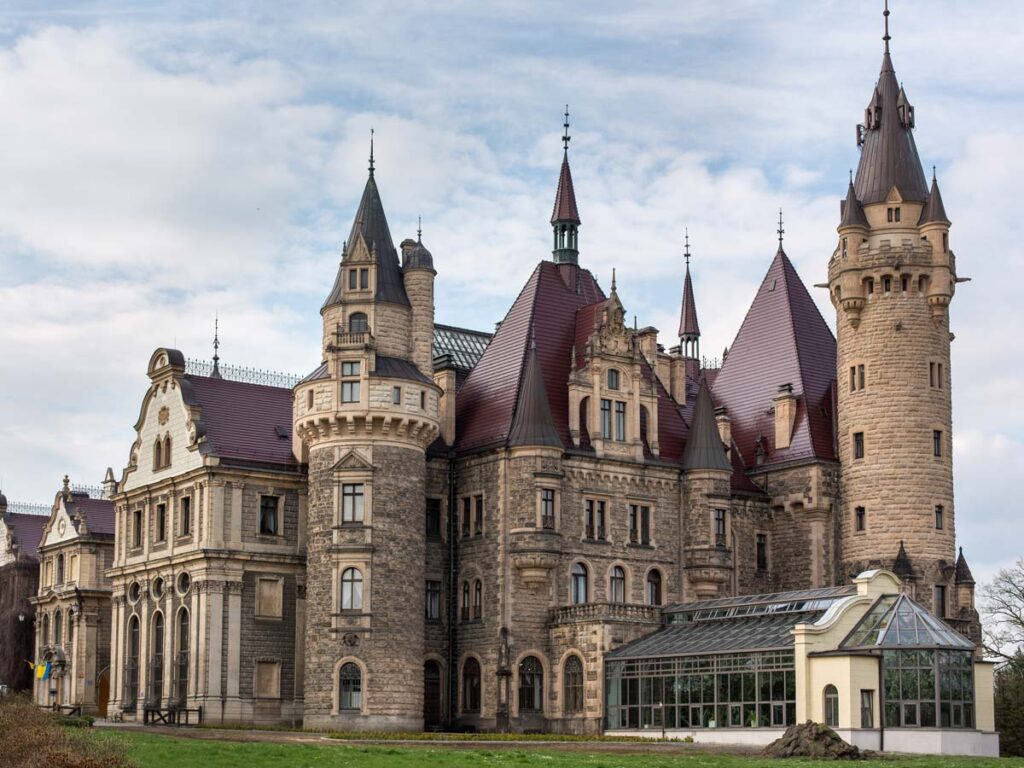
But, it’s the eastern Neogothic-styled wing that is the inspiration for our Disney castle. This portion of the castle was completed in 1900, along with the reconstructed central palace. It also seems to be the biggest contributor of turrets toward the 99 that the castle contains.
The Inspiration for Cinderella Castle
I confess that it’s probably too simplistic to focus on just one or two elements of these various castles when we’re pointing out their relationship to Cinderella Castle. There are so many little details from these historical buildings built into the design. However, that’s all this (checks word count) 2,700 word post will allow. With that said, I present the two most obvious elements from Moszna Castle seen in the design of Cinderella Castle.
Tower Profile

Well, here we see where that unique silhouette that the towers at the Castle at Magic Kingdom have comes from. Yes, the image on the right shows that Cinderella Castle has that Alcázar de Segovia tapered spire, that we saw previously. And the tower in the left-hand image contains several ornate windows that Florida’s lacks. But, the corbeled tower projection near the top is clearly Moszna-inspired. And the two-tiered roof sitting atop that wider portion – is also influenced by the Polish castle.
Ornate Dormers
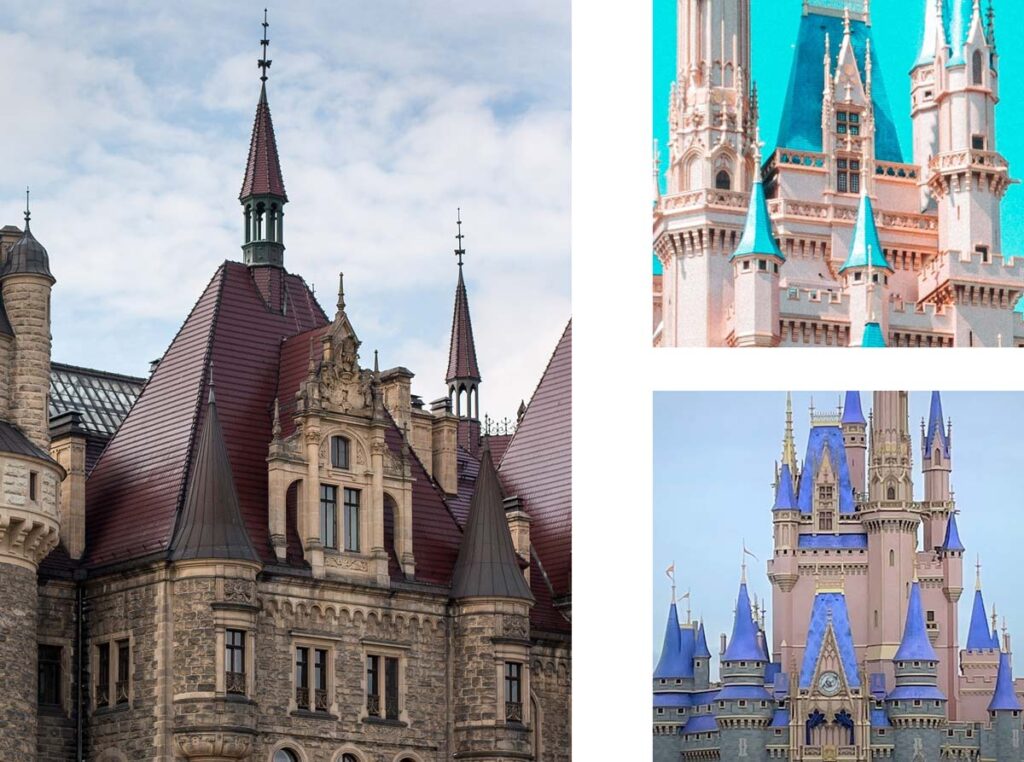
Moszna Castle also has examples of highly-decorated dormered windows in its steeply-sloped Mansard roofs, like the one above. Cinderella Castle at Magic Kingdom incorporates several of these incredibly ornate attic windows too. This architectural element adds a level of opulence, while giving an illusion of more towers and spires being part of the overall composition of the building. They also help to blur the line between wall and roof, without which both designs would arguably appear too straight-forward.
Château de Pierrefonds, France
Let’s end Part One by heading back to where we started – to the Castle Capital of the World, France. In Part Two, we’ll visit a few more in that country as well.
The Precedent
Château de Pierrefonds is a castle in the region of Picardy, France, which is characteristic of medieval fortresses. Built in the late 1300s, and besieged and partially razed in the 17th century, Napoleon III commissioned the castle to be restored over 28 years, until 1885.
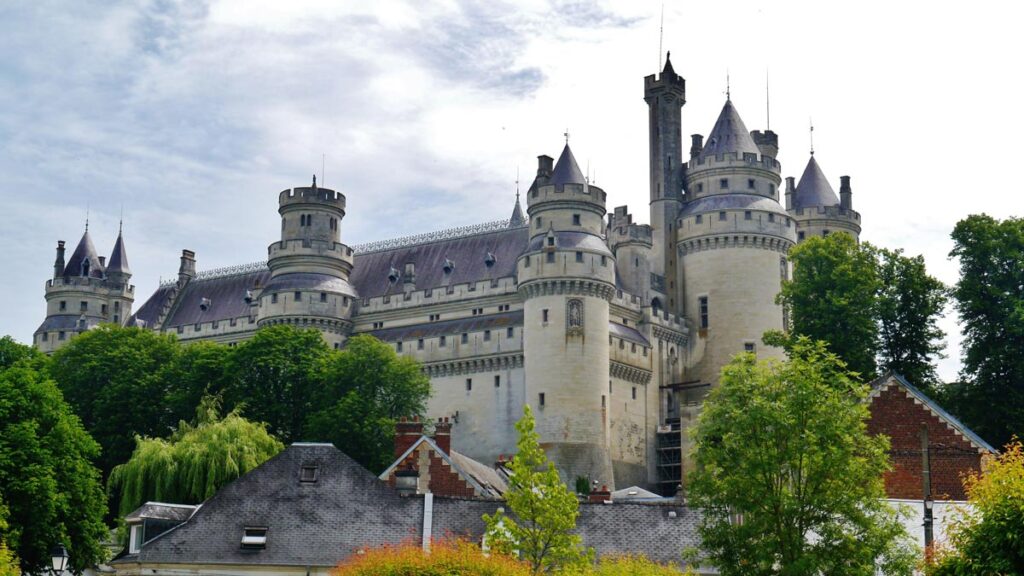
The style of the castle is essentially “medieval fortification”. While it is a beautiful piece of architecture, it’s focus is mainly military defense. But, even though Cinderella doesn’t need protection from the riffraff of Main Street, U.S.A., her castle still borrows this fortified look from the Château de Pierrefonds.
The Inspiration for Cinderella Castle
Cinderella Castle mostly borrows from the fortified curtain wall (the outer wall of the castle between towers that is purely for defense) and towers of Château de Pierrefonds. So, we’ll look at some of these elements that have influenced the Disney castle.
Curtain Wall

Despite its fantastical, soaring neogothic spires at its upper reaches, Cinderella Castle’s lower portion is fortified just like a medieval castle. And it seems to borrow heavily from the curtain walls of the Pierrefonds Castle that we see above. Note the projected parapet at the top of the wall, supported by stone brackets, as well as the crenellations (those notches that look like “teeth”) in the parapet (the low wall at the roof edge). Both are just like its source material, as seen below.
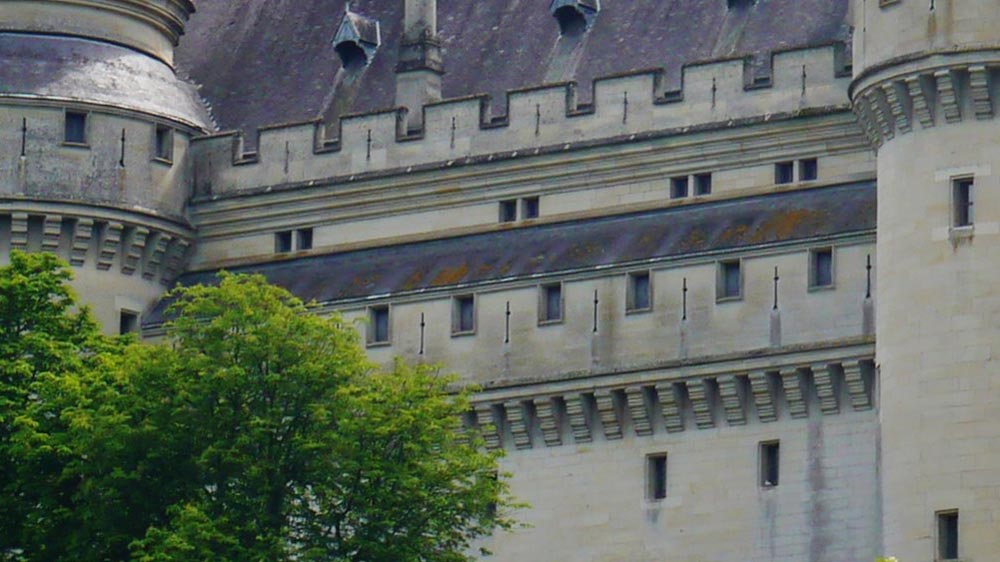
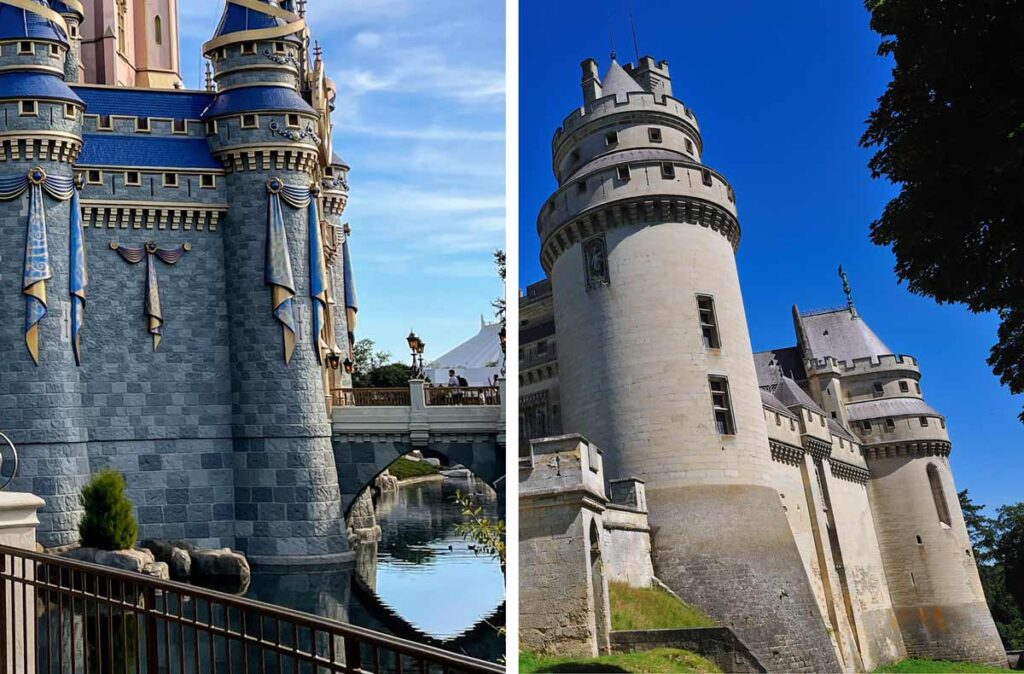
In addition, the bottom of the curtain walls of both castles – France and Florida – are battered (they thicken as they meet the ground). This is pretty certainly the main precedent for the lower wall of Cinderella Castle – the wall fortified because of the heathens on Main Street.
Towers
The towers, even though we’ve already seen that they’ve borrowed from several castle examples, are very similar to the ones at Château de Pierrefonds.

You can see above how much Cinderella Castle borrows from the Pierrefonds castle: the projecting top with corbels, the crenellations in the story above the corbel, the small roof that rings the slightly narrower tower portion above. Yes, Cinderella Castle crowns the towers with spires that spring right from the tower wall, whereas the French tower has a crenellated parapet and a roof that sits behind. But, there’s not doubt that these two are relatives.
And one specific tower on Cinderella Castle is inspired by Pierrefonds.
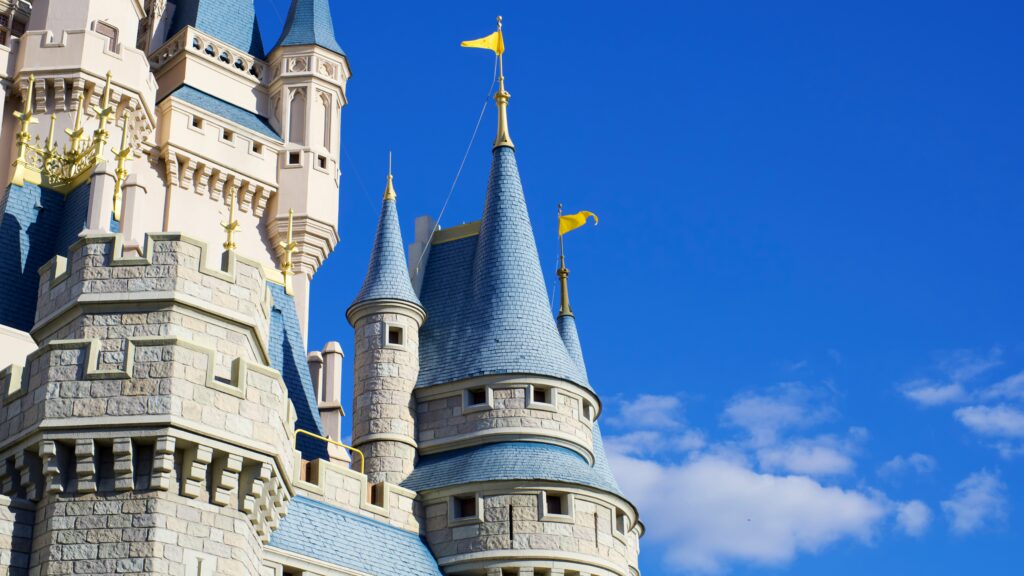
That’s the one. It’s totally unique… easy to miss… and I love it! This tower is stretched from the wall a bit, and thus, it’s spire has a “tail” of sorts. It’s also flanked by two small turrets. But what a fun, weird little composition. This is the kind of detail that makes me love Disney World.
Well, the Imagineers didn’t just make it up. They had some inspiration.
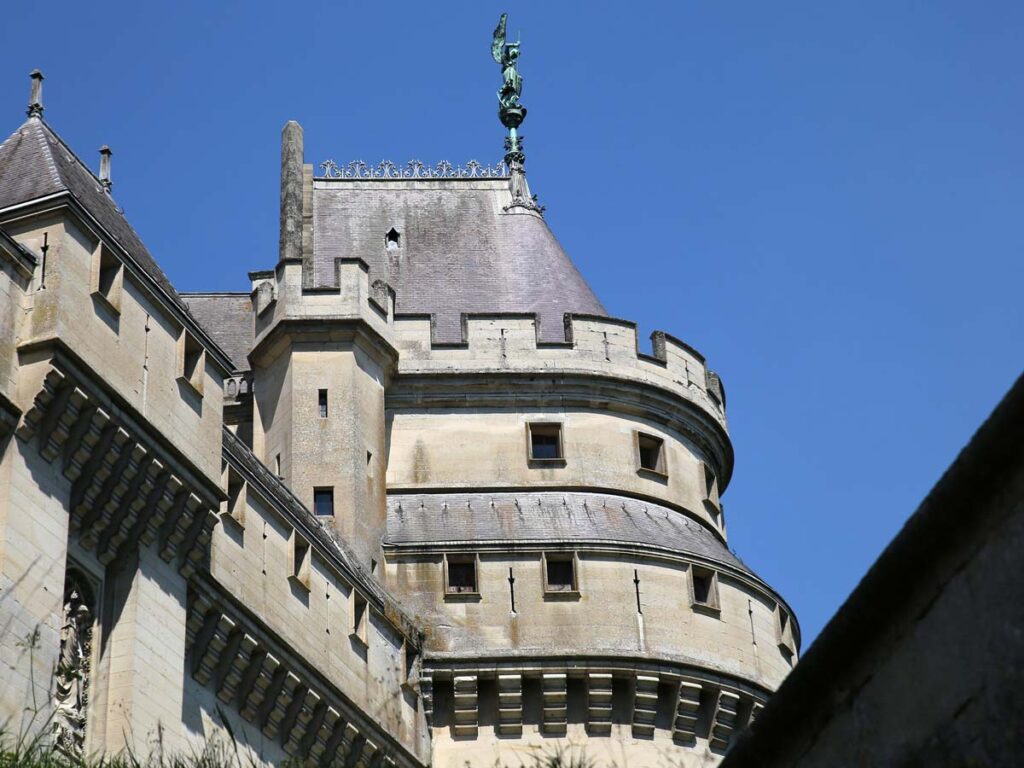
It’s certainly not a perfect match. The spire doesn’t protrude above the roof “tail” like in Florida. There is a parapet in front of the roof. The flanking turrets don’t have spires on them. But, man… it’s a close cousin, isn’t it?
Conclusion
There will be a Part II of this post, that covers the other 5 known castles that inspired Cinderella Castle. I find it fascinating that something so magical and fantastical is actually rooted in real-life medieval and neogothic European examples. Not surprised of course… this is how the Imagineers have always designed the architecture in their parks – using historical precedents like this.
Let me know what you think in the comments below…

